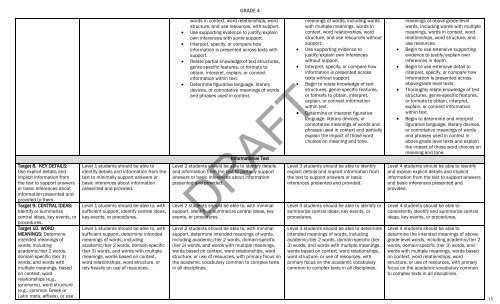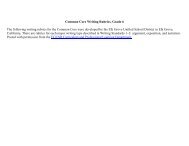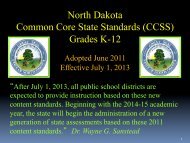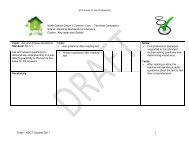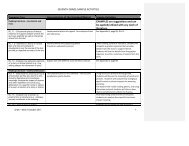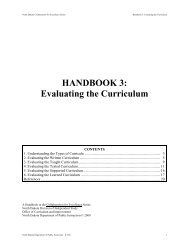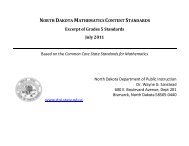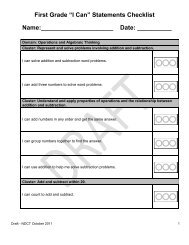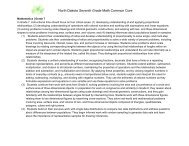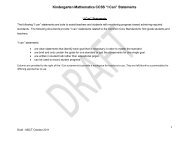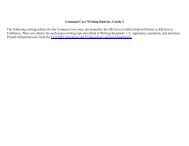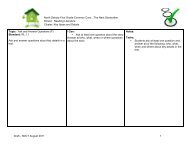SBAC Achievement Level Descriptors, Grade 4 - ND Curriculum ...
SBAC Achievement Level Descriptors, Grade 4 - ND Curriculum ...
SBAC Achievement Level Descriptors, Grade 4 - ND Curriculum ...
Create successful ePaper yourself
Turn your PDF publications into a flip-book with our unique Google optimized e-Paper software.
GRADE 4Target 8. KEY DETAILS:Use explicit details andimplicit information fromthe text to support answersor basic inferences aboutinformation presented andprovided to them.Target 9. CENTRAL IDEAS:Identify or summarizecentral ideas, key events, orprocedures.Target 10. WORDMEANINGS: Determineintended meanings ofwords, includingacademic/tier 2 words,domain-specific (tier 3)words, and words withmultiple meanings, basedon context, wordrelationships (e.g.,synonyms), word structure(e.g., common Greek orLatin roots, affixes), or use<strong>Level</strong> 1 students should be able toidentify details and information from thetext to minimally support answers orbasic inferences about informationpresented and provided.<strong>Level</strong> 1 students should be able to, withsufficient support, identify central ideas,key events, or procedures.<strong>Level</strong> 1 students should be able to, withsufficient support, determine intendedmeanings of words, includingacademic/tier 2 words, domain-specific(tier 3) words, and words with multiplemeanings, words based on context,word relationships, word structure, orrely heavily on use of resources.words in context, word relationships, wordstructure, and use resources, with support.• Use supporting evidence to justify/explainown inferences with some support.• Interpret, specify, or compare howinformation is presented across texts withsupport.• Relate partial knowledge of text structures,genre-specific features, or formats toobtain, interpret, explain, or connectinformation within text.• Determine figurative language, literarydevices, or connotative meanings of wordsand phrases used in context.Informational Text<strong>Level</strong> 2 students should be able to identify detailsand information from the text to partially supportanswers or basic inferences about informationpresented and provided.DRAFT<strong>Level</strong> 2 students should be able to, with minimalsupport, identify or summarize central ideas, keyevents, or procedures .<strong>Level</strong> 2 students should be able to, with minimalsupport, determine intended meanings of words,including academic/tier 2 words, domain-specific(tier 3) words, and words with multiple meanings,words based on context, word relationships, wordstructure, or use of resources, with primary focus onthe academic vocabulary common to complex textsin all disciplines.meanings of words, including wordswith multiple meanings, words incontext, word relationships, wordstructure, and use resources withoutsupport.• Use supporting evidence tojustify/explain own inferenceswithout support.• Interpret, specify, or compare howinformation is presented acrosstexts without support.• Begin to relate knowledge of textstructures, genre-specific features,or formats to obtain, interpret,explain, or connect informationwithin text.• Determine or interpret figurativelanguage, literary devices, orconnotative meanings of words andphrases used in context and partiallyexplain the impact of those wordchoices on meaning and tone.<strong>Level</strong> 3 students should be able to identifyexplicit details and implicit information fromthe text to support answers or basicinferences presented and provided.<strong>Level</strong> 3 students should be able to identify orsummarize central ideas, key events, orprocedures.<strong>Level</strong> 3 students should be able to determineintended meanings of words, includingacademic/tier 2 words, domain-specific (tier3) words, and words with multiple meanings,words based on context, word relationships,word structure, or use of resources, withprimary focus on the academic vocabularycommon to complex texts in all disciplines.meanings of above-grade-levelwords, including words with multiplemeanings, words in context, wordrelationships, word structure, anduse resources.• Begin to use extensive supportingevidence to justify/explain owninferences in depth.• Begin to use extensive detail tointerpret, specify, or compare howinformation is presented acrossabove-grade level texts.• Thoroughly relate knowledge of textstructures, genre-specific features,or formats to obtain, interpret,explain, or connect informationwithin text.• Begin to determine and interpretfigurative language, literary devices,or connotative meanings of wordsand phrases used in context inabove-grade level texts and explainthe impact of those word choices onmeaning and tone.<strong>Level</strong> 4 students should be able to identifyand explain explicit details and implicitinformation from the text to support answersand basic inferences presented andprovided.<strong>Level</strong> 4 students should be able toconsistently identify and summarize centralideas, key events, or procedures.<strong>Level</strong> 4 students should be able todetermine the intended meanings of abovegrade-levelwords, including academic/tier 2words, domain-specific (tier 3) words, andwords with multiple meanings, words basedon context, word relationships, wordstructure, or use of resources, with primaryfocus on the academic vocabulary commonto complex texts in all disciplines.15


